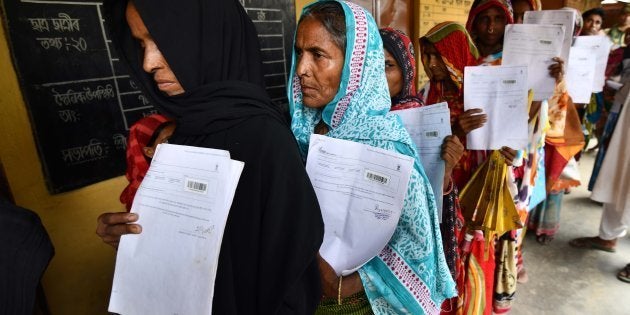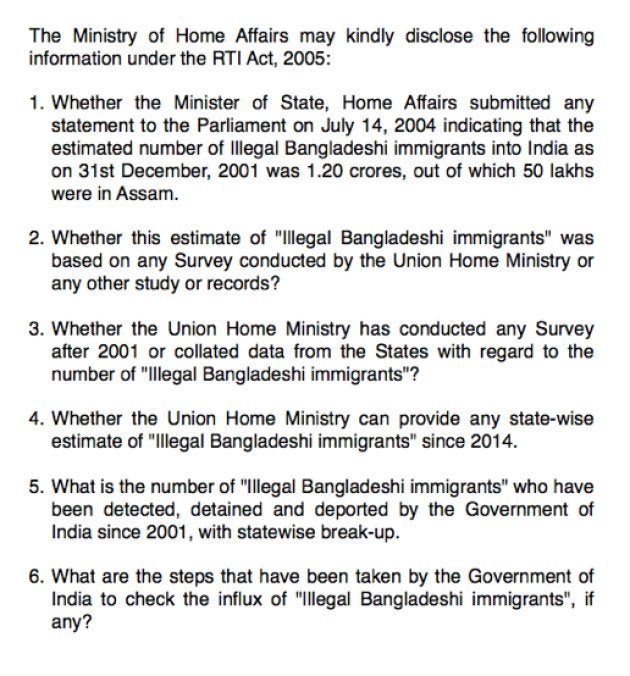
The process of updating Assam's National Register of Citizens (NRC) has been a difficult and distressing test for the state's population. Over 40 lakh people were left out of the draft published in July, leading to chaos and confusion as those not included try to find documents that will prove that they are legal residents of the country.
When the Supreme Court said in December 2014 that the NRC should be prepared in a time-bound manner, its order underlined the magnitude of Bangladeshi infiltration by quoting a vital piece of statistics:
On 14th July, 2004, in response to an unstarred question pertaining to deportation of illegal Bangladeshi migrants, the Minister of State, Home Affairs, submitted a statement to Parliament indicating therein that the estimated number of illegal Bangladeshi immigrants into India as on 31st December, 2001 was 1.20 crores, out of which 50 lakhs were in Assam.
However, a deeper dive into the numbers shows that the Supreme Court may have relied on hearsay to issue the order initiating the NRC updation process. A reply given by the Ministry of Home Affairs to an RTI application submitted by one of the authors shows that the government does not even know how many illegal immigrants are residing in the country.
Where did the '50 lakh' figure come from?
This is the only estimate of the number of illegal Bangladeshi immigrants in Assam that the SC judgement contained. The rest of the judgement had references to documents where Bangladeshi infiltration is mentioned, but no estimate was provided.
Magnitude matters. "50 lakh" is a very large number for Assam, whose population was less than 2.70 crore in 2001. If nearly one-fifth of the state's population comprises illegal Bangladeshi immigrants, tough measures would appear reasonable and justified.
The NRC exercise has asked every person residing in Assam to prove her/his legitimacy by producing documents which were issued before 24 March 1971. How many poor, illiterate people can do that? The number of people who committed suicide after not being included in the NRC draft reflects that social pain and agony. Yet, it was the gravity of the situation, underlined by the figure of "50 lakh illegal Bangladeshi immigrants" residing in Assam, which provided the judicial and political justification for the NRC updation. However, after the then Minister of State for Home Affairs, Sriprakash Jaiswal, said in Parliament in July 2004 that 1.2 crore illegal Bangladeshis were residing in India, a political controversy had erupted. Subsequently, the minister retracted his statement and issued the following clarification:
Statement correcting answer to the Rajya Sabha Unstarred Question No. 332 answered on 14th July, 2004 on the subject of Illegal Bangladeshi Migrants:
In reply to part (c) of the Rajya Sabha Unstarred Question No. 332, answered on 14th July, 2004, the state-wise details on the number of illegal Bangladeshi migrants was given as an Annexure. The estimated number of illegal immigrants reported by the field organisation had a clarificatory note, which was inadvertently not seen. The clarificatory note made it clear that the reported figures were not based on any comprehensive or sample study but were based on hearsay and that too from interested parties. Therefore, no realistic figures can be given for illegal Bangladeshi migrants in Assam. In the case of West Bengal also the figures are based on unreliable estimates and are incorrect.
This clarification is available on the Rajya Sabha website. However, the SC judgement on NRC has clearly ignored this clarification given by the Home Ministry.
After the judgement was passed, Kiren Rijiju, the current Minister of State for Home Affairs, made the following statement in the Rajya Sabha on 16 November 2016:
Rajya Sabha Unstarred Question Nos. 55 on the Deportation of Illegal Bangladeshi Migrants
There are reports of Bangladeshi nationals having entered the country without valid travel documents. Since entry of such Bangladeshi nationals into the country is clandestine and surreptitious, it is not possible to have accurate data of such Bangladeshi nationals living in various parts of the country. As per available inputs, there are around 20 million illegal Bangladeshi migrants staying in India.
The Times of India hadquoted an unidentified Union minister as saying then that "unlike UPA, we won't be cowed down by pressure to deny the figure as 'hearsay'".
RTI application
We had filed an RTI application with the Ministry of Home Affairs on 5 September 2018, seeking to know the basis of the data of 1.20 crore illegal Bangladeshi migrants in India reported in the Parliament by the ministry in July 2004.


So the Union home ministry, in its response to our RTI queries, not only did not corroborate the figure of 1.20 crore illegal Bangladeshi migrants which was quoted in the SC judgement in December 2014 or the 20 million (2 crore) figure reported by the MoS, Home Affairs, in November 2016, it has now stated that:
...it is no (sic) possible to have an accurate estimate of such illegal migrants including Bangladeshi immigrants living in the country.
If no accurate estimate is possible, the figure of "50 lakh illegal Bangladeshi immigrants" residing in Assam, which formed a basis of the SC judgement initiating the NRC updating process, turns out to be nothing more than hearsay. Should a mammoth exercise like the NRC updation, which involves substantial fiscal and social costs, have been initiated on the basis of this?
While deliberating on the matter, the SC should have taken into account academic work done by several scholars on Assam, who have questioned the narrative of humongous illegal infiltration from Bangladesh on the basis of demographic data. The SC could have also ordered a survey undertaken by a competent state agency to find out the facts regarding illegal immigration in Assam, in order to establish its actual extent.
ALSO READ: This Graphic Novelist Sketches The Citizenship Test That May Render Millions In Assam Stateless
Indian census data show that between 1951 and 1971, Assam's population was growing at a rate much faster than India's population. This points towards immigration from East Pakistan, especially in the backdrop of the tumultuous political situation there during this period owing to the language movement, repression by the Pakistan army and finally the Bangladesh liberation war. After 1971, however, the demographic trend has decidedly changed.
Assam's population after 1971 has been growing at a comparable rate with the all-India population, if not marginally lower. Compared with its East Indian neighbour Jharkhand, which is similar to Assam in many respects, Assam's population has been growing at a much slower rate. Nobody makes a case that mass Bangladeshi infiltration is taking place in Jharkhand. Why should the unfounded claim of "50 lakh illegal Bangladeshi immigrants" residing in Assam be accorded any credibility by the Supreme Court or the Union Government?
Since it has turned out that the NRC updating exercise is not based on facts regarding illegal Bangladeshi immigration, it is perhaps worthwhile to reflect on the justifiability of continuing with the entire exercise, which has already cost the lives of helpless, ordinary people.
Debarshi Das teaches in the Department of Humanities and Social Sciences at the Indian Institute of Technology, Guwahati.
Prasenjit Bose is an economist and activist based in Kolkata.